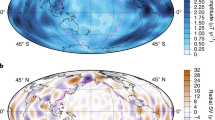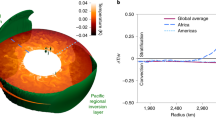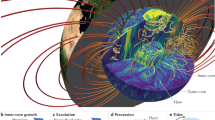Abstract
Thermal interactions between Earth’s core and mantle provide the power that maintains the geomagnetic field. However, the effect of these interactions and, in particular, the thermochemical piles at the base of the mantle on magnetic field behaviour remains uncertain. Here we present numerical dynamo simulations with strong lateral variations in heat flow imposed at the core–mantle boundary to reproduce conditions within Earth and indicate how the mantle controls core dynamics. Comparing these simulations to recent global magnetic field models, based on observational data spanning tens of thousands of years, they successfully reproduce the morphology and secular variation of Earth’s modern field and the inferred large-scale flow structure at the top of the core. These simulations reveal that the long-term geomagnetic signatures of thermal core–mantle interactions are evident in the longitudinal structure of the geomagnetic field as equatorial patches of reverse flux, rather than the high-latitude patches suggested by less Earth-like simulations. Comparison of these simulations with the field models also suggests that the amplitude of the present-day longitudinal hemispheric imbalance in secular variation is anomalously large, indicating our present-day geomagnetic field may be unusual.
This is a preview of subscription content, access via your institution
Access options
Access Nature and 54 other Nature Portfolio journals
Get Nature+, our best-value online-access subscription
$29.99 / 30 days
cancel any time
Subscribe to this journal
Receive 12 print issues and online access
$259.00 per year
only $21.58 per issue
Buy this article
- Purchase on Springer Link
- Instant access to full article PDF
Prices may be subject to local taxes which are calculated during checkout




Similar content being viewed by others
Data availability
Original data underlying the figures and plain text versions of tables are available at github.com/jonmound/MD2023data.
Code availability
For access to the github repository containing the Leeds dynamo code, please contact the corresponding author.
References
Landeau, M., Fournier, A., Nataf, H.-C., Cébron, D. & Schaeffer, N. Sustaining Earth’s magnetic dynamo. Nat. Rev. Earth Environ. 3, 255–269 (2022).
Nakagawa, T. & Tackley, P. J. Lateral variations in CMB heat flux and deep mantle seismic velocity caused by a thermal-chemical-phase boundary layer in 3D spherical convection. Earth Planet. Sci. Lett. 271, 348–358 (2008).
Stackhouse, S., Stixrude, L. & Karki, B. B. First-principles calculations of the lattice thermal conductivity of the lower mantle. Earth Planet. Sci. Lett. 427, 11–17 (2015).
Olson, P., Coe, R., Driscoll, P., Glatzmaier, G. & Roberts, P. Geodynamo reversal frequency and heterogeneous core–mantle boundary heat flow. Phys. Earth Planet. Inter. 180, 66–79 (2010).
Laj, C., Mazaud, A., Weeks, R., Fuller, M. & Herrrero-Bervera, E. Geomagnetic reversal paths. Nature 351, 447 (1991).
Doell, R. R. & Cox, A. Pacific geomagnetic secular variation. Science 171, 248–254 (1971).
Gubbins, D. in Earth’s Core: Dynamics, Structure, Rotation (eds Dehant, V. et al.) 163–179 (American Geophysical Union, 2003).
Panovska, S., Constable, C. G. & Korte, M. Extending global continuous geomagnetic field reconstructions on timescales beyond human civilization. Geochem. Geophys. Geosyst. 19, 4757–4772 (2018).
Jackson, A., Jonkers, A. R. T. & Walker, M. R. Four centuries of geomagnetic secular variation from historical records. Philos. Trans. R. Soc. A 358, 957–990 (2000).
Panovska, S., Korte, M. & Constable, C. G. One hundred thousand years of geomagnetic field evolution. Rev. Geophys. 57, 1289–1337 (2019).
Finlay, C. C. et al. The CHAOS-7 geomagnetic field model and observed changes in the South Atlantic Anomaly. Earth Planets Space 72, 156 (2020).
Panovska, S. & Constable, C. G. An activity index for geomagnetic paleosecular variation, excursions, and reversals. Geochem. Geophys. Geosyst. 18, 1366–1375 (2017).
Korte, M. & Constable, C. Improving geomagnetic field reconstructions for 0–3 ka. Phys. Earth Planet. Inter. 188, 247–259 (2011).
Korte, M., Constable, C., Donadini, F. & Holme, R. Reconstructing the Holocene geomagnetic field. Earth Planet. Sci. Lett. 312, 497–505 (2011).
Nilsson, A., Holme, R., Korte, M., Suttie, N. & Hill, M. Reconstructing Holocene geomagnetic field variation: new methods, models and implications. Geophys. J. Int. 198, 229–248 (2014).
Mound, J., Davies, C. & Silva, L. Inner core translation and the hemispheric balance of the geomagnetic field. Earth Planet. Sci. Lett. 424, 148–157 (2015).
Holme, R. Large-Scale Flow in the Core: Treatise on Geophysics 2nd edn (Elsevier, 2015).
Jackson, A., Bloxham, J. & Gubbins, D. in Dynamics of Earth’s Deep Interior and Earth Rotation (eds J.-L. Le Mouël, D. E. Smylie & T. Herring) 97–107 (IUGG and AGU, 1993).
Barrois, O., Hammer, M. D., Finlay, C. C., Martin, Y. & Gillet, N. Assimilation of ground and satellite magnetic measurements: inference of core surface magnetic and velocity field changes. Geophys. J. Int. 215, 695–712 (2018).
Whaler, K. A., Hammer, M. D., Finlay, C. C. & Olsen, N. Core surface flow changes associated with the 2017 Pacific geomagnetic jerk. Geophys. Res. Lett. 49, e2022GL098616 (2022).
Pais, M. A. & Jault, D. Quasi-geostrophic flows responsible for the secular variation of the Earth’s magnetic field. Geophys. J. Int. 173, 421–443 (2008).
Gillet, N., Jault, D. & Finlay, C. C. Planetary gyre, time-dependent eddies, torsional waves and equatorial jets at the Earth’s core surface. J. Geophys. Res. B: Solid Earth 120, 3991–4013 (2015).
Willis, A. P., Sreenivasan, B. & Gubbins, D. Thermal core–mantle interaction: exploring regimes for ‘locked’ dynamo action. Phys. Earth Planet. Inter. 165, 83–92 (2007).
Christensen, U. R., Aubert, J. & Hulot, G. Conditions for Earth-like geodynamo models. Earth Planet. Sci. Lett. 296, 487–496 (2010).
Davies, C. J. & Constable, C. G. Insights from geodynamo simulations into long-term geomagnetic field behaviour. Earth Planet. Sci. Lett. 404, 238–249 (2014).
Aubert, J., Finlay, C. C. & Fournier, A. Bottom-up control of geomagnetic secular variation by the Earth’s inner core. Nature 502, 219–223 (2013).
Davies, C. J., Stegman, D. R. & Dumberry, M. The strength of gravitational core–mantle coupling. Geophys. Res. Lett. 41, 3786–3792 (2014).
Pozzo, M., Davies, C., Gubbins, D. & Alfè, D. Thermal and electrical conductivity of solid iron and iron–silicon mixtures at Earth’s core conditions. Earth Planet. Sci. Lett. 393, 159–164 (2014).
Labrosse, S. Thermal and compositional stratification of the inner core. C.R. Geosci. 346, 119–129 (2014).
Lythgoe, K. H., Rudge, J. F., Neufeld, J. A. & Deuss, A. The feasibility of thermal and compositional convection in Earth’s inner core. Geophys. J. Int. 201, 764–782 (2015).
Deguen, R., Alboussiére, T. & Labrosse, S. Double-diffusive translation of Earth’s inner core. Geophys. J. Int. 214, 88–107 (2018).
Gubbins, D. & Kelly, P. Persistent patterns in the geomagnetic field over the past 2.5 Myr. Nature 365, 829–832 (1993).
Gubbins, D., Willis, A. P. & Sreenivasan, B. Correlation of Earth’s magnetic field with lower mantle thermal and seismic structure. Phys. Earth Planet. Inter. 162, 256–260 (2007).
Olson, P., Landeau, M. & Reynolds, E. Dynamo tests for stratification below the core–mantle boundary. Phys. Earth Planet. Int. 271, 1–18 (2017).
Meduri, D. G. et al. Numerical dynamo simulations reproduce paleomagnetic field behavior. Geophys. Res. Lett. 48, e2020GL090544 (2021).
Aubert, J., Gastine, T. & Fournier, A. Spherical convective dynamos in the rapidly rotating asymptotic regime. J. Fluid Mech. 813, 558–593 (2017).
Aubert, J. Approaching Earth’s core conditions in high-resolution geodynamo simulations. Geophys. J. Inter. 219, S137–S151 (2019).
Davies, C. J. & Mound, J. E. Mantle-induced temperature anomalies do not reach the inner core boundary. Geophys. J. Inter. 219, S21–S32 (2019).
Mound, J. E. & Davies, C. J. Scaling laws for regional stratification at the top of Earth’s core. Geophys. Res. Lett. 47, e2020GL087715 (2020).
Olson, P. & Christensen, U. R. The time-averaged magnetic field in numerical dynamos with non-uniform boundary heat flow. Geophys. J. Inter. 151, 809–823 (2002).
Sahoo, S. & Sreenivasan, B. Response of Earth’s magnetic field to large lower mantle heterogeneity. Earth Planet. Sci. Lett. 549, 116507 (2020).
Finlay, C. C., Jackson, A., Gillet, N. & Olsen, N. Core surface magnetic field evolution 2000–2010. Geophys. J. Inter. 189, 761–781 (2012).
Dumberry, M. & More, C. Weak magnetic field changes over the Pacific due to high conductance in lowermost mantle. Nat. Geosci. 13, 516–520 (2020).
Masters, G., Johnson, S., Laske, G. & Bolton, H. A shear-velocity model of the mantle. Phil. Trans. R. Soc. A 354, 1385–1411 (1996).
Holme, R., Olsen, N. & Bairstow, F. L. Mapping geomagnetic secular variation at the core–mantle boundary. Geophys. J. Inter. 186, 521–528 (2011).
Mound, J. E. & Davies, C. J. Heat transfer in rapidly rotating convection with heterogeneous thermal boundary conditions. J. Fluid Mech. 828, 601–629 (2017).
Mound, J., Davies, C., Rost, S. & Aurnou, J. Regional stratification at the top of Earth’s core due to core–mantle boundary heat flux variations. Nat. Geosci. 12, 575–580 (2019).
Long, R. S., Mound, J. E., Davies, C. J. & Tobias, S. M. Scaling behaviour in spherical shell rotating convection with fixed-flux thermal boundary conditions. J. Fluid Mech. 889, A7 (2020).
Schaeffer, N., Jault, D., Nataf, H. C. & Fournier, A. Turbulent geodynamo simulations: a leap towards Earth’s core. Geophys. J. Inter. 211, 1–29 (2017).
McNamara, A. K. A review of large low shear velocity provinces and ultra low velocity zones. Tectonophysics 760, 199–220 (2019).
Olson, P., Deguen, R., Rudolph, M. L. & Zhong, S. Core evolution driven by mantle global circulation. Phys. Earth Planet. Inter. 243, 44–55 (2015).
Dziewonski, A. M. & Anderson, D. L. Preliminary reference Earth model. Phys. Earth Planet. Inter. 25, 297–356 (1981).
Ichikawa, H., Tsuchiya, T. & Tange, Y. The P–V–T equation of state and thermodynamic properties of liquid iron. J. Geophys. Res. 119, 240–252 (2014).
Davies, C., Pozzo, M., Gubbins, D. & Alfè, D. Constraints from material properties on the dynamics and evolution of Earth’s core. Nat. Geosci. 8, 678–685 (2015).
Konôpková, Z., McWilliams, R. S., Gómez-Pérez, N. & Goncharov, A. F. Direct measurement of thermal conductivity in solid iron at planetary core conditions. Nature 534, 99–101 (2016).
Hirose, K., Wood, B. & Voçadlo, L. Light elements in the Earth’s core. Nat. Rev. Earth Environ. 2, 645–658 (2021).
Tassin, T., Gastine, T. & Fournier, A. Geomagnetic semblance and dipolar–multipolar transition in top-heavy double-diffusive geodynamo models. Geophys. J. Inter. 226, 1897–1919 (2021).
Aurnou, J. M. et al. Rotating convective turbulence in Earth and planetary cores. Phys. Earth Planet. Inter. 246, 52–71 (2015).
Orszag, S. A. Numerical simulation of incompressible flows within simple boundaries. I. Galerkin (spectral) representations. Stud. Appl. Math. 50, 293–327 (1971).
Schwaiger, T., Gastine, T. & Aubert, J. Force balance in numerical geodynamo simulations: a systematic study. Geophys. J. Inter. 219, S101–S114 (2019).
Hunter, J. D. Matplotlib: a 2D graphics environment. Comput. Sci. Eng. 9, 90–95 (2007).
Cartopy: A Cartographic Python Library with a Matplotlib Interface (Met Office, 2015); http://scitools.org.uk/cartopy
Acknowledgements
We thank C. Constable for useful discussion that improved this work. C.J.D. acknowledges funding via a Natural Environment Research Council Pushing the Frontiers award, reference NE/V010867/1. The funders had no role in study design, data collection and analysis, decision to publish or preparation of the manuscript. Figures were produced using Matplotlib61 and Cartopy62. This work used the ARCHER UK National Supercomputing Service (http://www.archer.ac.uk) and ARC2, part of the High Performance Computing facilities at the University of Leeds, UK.
Author information
Authors and Affiliations
Contributions
J.E.M. and C.J.D. both conceived of the study, carried out and analysed the simulations and co-wrote the paper.
Corresponding author
Ethics declarations
Competing interests
The authors declare no competing interests.
Peer review
Peer review information
Nature Geoscience thanks Nathanaël Schaeffer, Andreas Nilsson and the other, anonymous, reviewer(s) for their contribution to the peer review of this work. Primary Handling Editor: Louise Hawkins, in collaboration with the Nature Geoscience team.
Additional information
Publisher’s note Springer Nature remains neutral with regard to jurisdictional claims in published maps and institutional affiliations.
Extended data
Extended Data Fig. 1 Time-averaged magnetic fields.
Time-averaged magnetic fields. Maps are for GGF100k (a) and our simulations with Ra = 6000 and q* = 2.3, 5.0 (b,c). The radial component of the magnetic field on the CMB truncated at spherical harmonic degree and order 4. Note that the simulations use a non-dimensional scale.
Extended Data Fig. 2 Evolution of the contributions to magnetic field and secular variation semblance over our simulations.
Evolution of the contributions to magnetic field and secular variation semblance over our simulations. The χ2 contribution from the O/E, Z/NZ, AD/NAD, FCF, and Hsv measures are given by the orange, green, red, purple, and brown filled areas, respectively. The black solid line highlights the sum of the four compliance criteria for the magnetic field geometry and the grey horizontal lines indicate the values below which this total compliance is considered excellent, good, or marginal in comparison with Earth as derived from gufm1. Values to the right of each panel indicate the percentage of 400-year windows that fall in each compliance band. Simulations have Ra = 2000 (panels a,b,c) or Ra = 6000 (panels d,e,f) and q* = 0.0 (a,d), q* = 2.3 (b,e), or q* = 5.0 (c,f).
Extended Data Fig. 3 Time-averaged radial magnetic field at the core–mantle boundary in the equatorial regions of the simulations.
Time-averaged radial magnetic field at the core–mantle boundary in the equatorial regions of the simulations. Runs are characterised by Ra = 6000 and q* = 2.3, 5 (a,b). Both plots use the same colour scale for the (non-dimensional) magnetic field strength and are truncated at spherical harmonic degree and order 8.
Extended Data Fig. 4 Time-averaged values of the paleosecular variation index from our simulations.
Time-averaged values of the paleosecular variation index from our simulations. Runs are characterised by Ra = 2000 and q* = 0, 2.3, 5 (a,c,e); Ra = 6000 and q* = 2.3, 5 (d,f). The final map is GGF100k (b). All plots use the same colour scale.
Rights and permissions
Springer Nature or its licensor (e.g. a society or other partner) holds exclusive rights to this article under a publishing agreement with the author(s) or other rightsholder(s); author self-archiving of the accepted manuscript version of this article is solely governed by the terms of such publishing agreement and applicable law.
About this article
Cite this article
Mound, J.E., Davies, C.J. Longitudinal structure of Earth’s magnetic field controlled by lower mantle heat flow. Nat. Geosci. 16, 380–385 (2023). https://doi.org/10.1038/s41561-023-01148-9
Received:
Accepted:
Published:
Issue Date:
DOI: https://doi.org/10.1038/s41561-023-01148-9
This article is cited by
-
Gyres, jets and waves in the Earth’s core
Nature Reviews Earth & Environment (2023)



